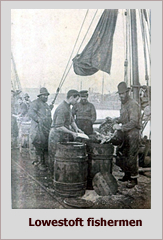My father was born in Lowestoft in 1910 and tracing his ancestors has proved a lot easier than pursuing my mother’s lot around Somerset and various parts of Wales. With the help of films ordered at the LDS, I have traced many of my father’s direct lines back to the beginning of parish records.
Most of his family still live in and around Lowestoft and I have lots of relations there. Dad’s explanation as to why the family stayed put was that there was no need to move because there was always fish in the sea and vegetables in the garden, so most people were happy to stay there.

Lowestoft is mentioned in the Domesday Book and at that time it was a small agricultural community of around 100 people. In the Middle Ages it developed into a fishing port, although agriculture was still very important, and still is today. There were several manors around Lowestoft and all employed agricultural labourers.
I joined a family history workshop when I began researching and it was something of a joke amongst us that I had been researching for a year and had yet to find an ag lab. I had lots of trawlermen and fishermen and various trades people, who I found in the census, but no ag labs. Eventually my Blundeston Seeleys and Bultitudes turned up in the 1841 census and some of them were ag labs working for the local estate.
I read a little about ag labs in the area and discovered that they were better off than many elsewhere because of the herring fishing in nearby Lowestoft. The ‘silver darlin’s’, as herring were known in those parts, have an annual migration around the country. Full time fishermen followed them around the country. The herring arrived off the east coast during the winter.
Winter was a difficult time for most ag labs.
The harvest was in and the land prepared for the next season, so there was little work to be had unless you lived on the east coast. Ag labs would sign on for the ‘home fishing’, as it was called, and could earn enough money to see them through the winter.
There were well-worn footpaths and trails from the inland villages to the coast at Lowestoft, established by the ag labs as they walked to the docks and home again. Some found that fishing and related industries paid much better so moved the few miles to the coast and into Lowestoft itself. By 1851 I had no ag labs in my direct line – which explains why it took me so long to find any.
The money was probably better and the housing more modern, but labouring on the docks or life on a trawler was hard. Living conditions were cramped with shared yards and facilities, and sanitation was not good. A pall of smoke hung over the town as the herrings were smoked. I often wonder if the families missed the space and fresh air of the countryside just 5 miles away.
Guinevere
© Guinevere 2007
